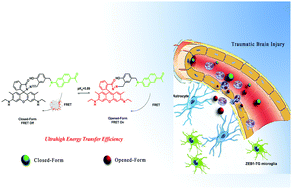A FRET-based two-photon probe for in vivo tracking of pH during a traumatic brain injury process†
Abstract
The traumatic brain injury (TBI) process, a significant cause of neurodegenerative diseases, is generally thought to be accompanied by a decrease in pH of the intracellular environment. In this work, a fluorescence resonance energy transfer (FRET)-based ratiometric two-photon fluorescent pH probe, FRET-pH, has been designed and fully characterized to monitor the pH change so as to understand the extent of the TBI process. FRET-pH, which has nearly 100% energy transfer efficiency and ∼100-fold ratio signal changes, is constructed from a naphthalene derivative ADN as a two-photon fluorophore and SRhB as a recognition domain for pH. FRET-pH displays both one- and two-photon ratiometric responses towards pH in aqueous solution. The appropriate pKa value (5.89) supports its use in subsequent biological applications. Finally, two-photon microscopic imaging of pH in living HeLa cells, BV-2 cells and rat brain tissue has been achieved.



 Please wait while we load your content...
Please wait while we load your content...